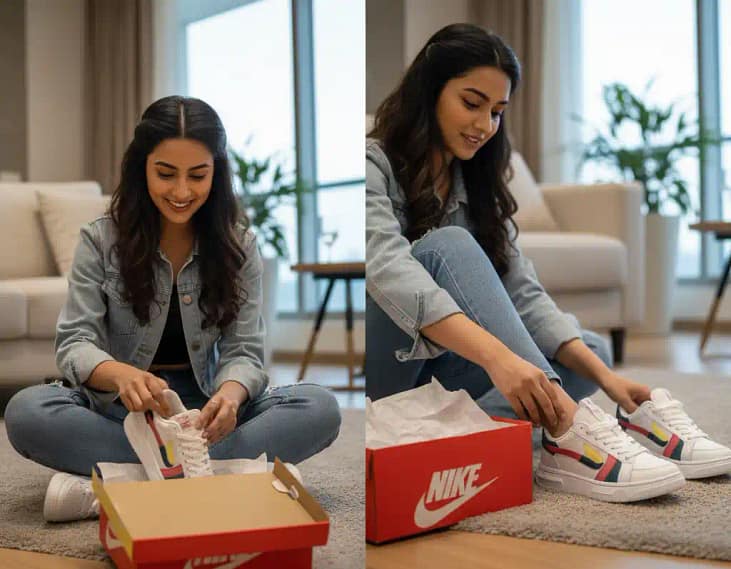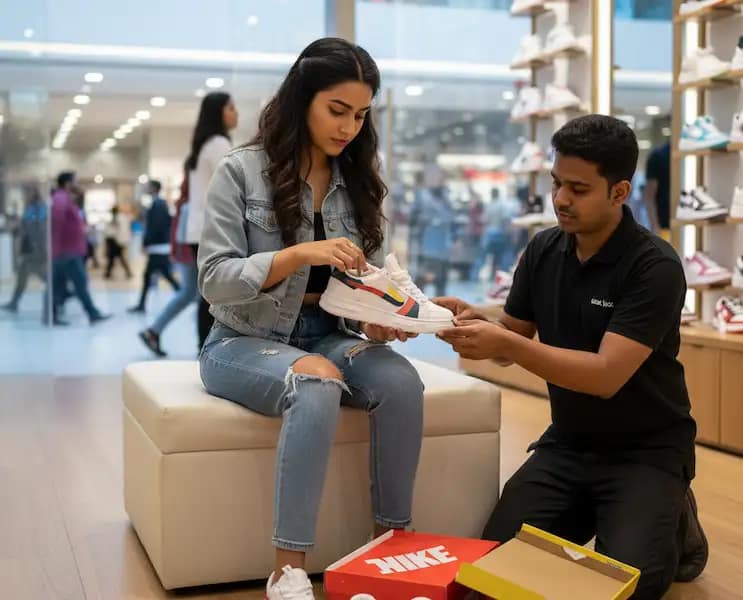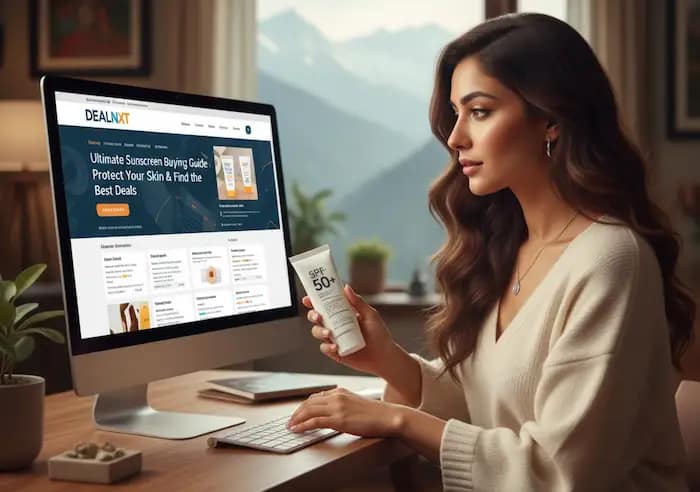Buying sneaker shouldn’t feel like a test. In this sneaker buying guide women India, picture a normal week: a metro dash on slick tiles, a two-wheeler ride after light rain, office stairs before a meeting, then errands in the evening. One pair has to do it all look neat with trousers or dresses, feel good from 9 to 9, and clean up fast. As per my opinion, comfort you can feel on day one and shoes that match your real routine beat any big logo or hype. Tight toes, slippery soles, and “it will break in later” are red flags you can avoid with a few simple checks.
What you’ll get here is a calm, practical path to the right pair. We’ll start by choosing purpose (office, walking, gym, travel), then fix fit in minutes (toe room, width, heel hold). Next, we’ll pick your preferred ride (soft, balanced, or firm), learn grip for Indian floors, and compare materials (breathable vs wipe-clean). You’ll also get a quick try-on routine that avoids returns, a simple online buying plan of sneaker for India, and an easy care habit that keeps sneakers fresh. The goal is confidence, not guesswork.
TL;DR (Quick Summary)
Sneaker Buying Guide Women India — How This Sneaker Buying Guide Works
One calm sequence—purpose → fit → ride → grip → care—removes guesswork. Use the ten-minute insole, walk, and stairs tests to confirm comfort now, then check outsole and materials for your real floors and climate.
Use this overview to make a fast short list, then read the deeper sections to confirm your choice.
Use these clear rules to shortlist sneaker without guesswork.
- Choose by purpose first (office, walking, gym, travel) so the shoe fits your real week.
- Confirm fit: 5–10 mm toe room, natural width, and steady heel hold with your usual socks.
- Pick your “ride”: soft for plush comfort, balanced for everyday, firm/stable for gym and quick turns.
- Check grip for your actual floors: real rubber with many small grooves grips tiles better than hard foam.
- Match materials to heat and cleaning time: mesh for breathability; synthetic leather for easy wipe-clean.
- Shop smart online: test indoors on delivery day, keep packaging perfect, and set the return reminder.
Next step: Tested picks with prices → /best-waterproof-sneakers-women-india-2025-reviews
1) Decide Your Purpose First (the fast way to shortlist Sneaker)
Quick map from use case to the features you should prioritise before buying of sneaker:
- Office/commute → low-profile neutral; all-day neat.
- Daily walking → balanced cushioning; breathable upper.
- Gym/classes → stable base; flexible forefoot (avoid tall, soft soles).
- Travel → light, versatile; removable insole for quick drying.
Sneaker is made for different jobs. When the design matches your main use, comfort lasts longer and outfits look better. This step saves time because it removes pairs that were never meant for your routine.
Use these purpose checks to do the shortlist of sneaker that fits your actual week.
- Office / commute: Pick a low-profile, clean design in a neutral shade. It pairs well with trousers, dresses, and sets and looks neat in meetings all day.
- Daily walking / errands: Choose balanced cushioning, a breathable upper, and a secure heel hold so long days feel easy and your steps stay steady.
- Training / gym / classes: Select a stable base and a flexible forefoot. Avoid very tall, very soft soles that feel wobbly under weights or quick side steps.
- Travel / long days out: Go light, breathable, and versatile. A removable insole helps quick drying and lets one pair match many outfits on the trip.
- Mixed use: If your week is split, choose based on the activity you spend the most hours doing; let that decide the shoe type.
Key takeaway: Decide your purpose first, colour second—this single choice shortens shopping time and reduces returns.
2) Fit Basics That Avoid Pain
Size translation tip: If you shop in US/EU sizes, use the brand chart and fit the larger foot; women-specific lasts often lock the heel better than unisex shapes.
Good fit is simple and you can test it in minutes. If a sneaker hurts in the shop, it will hurt more outside. Comfortable length, natural width, and a steady heel hold prevent blisters and toe bumps.
Follow these fit cues to get day-one comfort without guesswork.
- Length: Leave 5–10 mm beyond your longest toe so it never hits the front on stairs or slopes.
- Width: The widest part of your foot should sit inside the shoe comfortably, with no squeezing or bulging at the sides.
- Toe box shape: If your big toe feels pushed inward by narrow fronts, pick a rounder or roomier toe box for natural alignment.
- Heel hold: Walk for a minute and watch the heel. It should not lift up and down; a steady heel feels safe and reduces rubbing.
- Sock reality: Try with the socks you actually wear most days—usually thin everyday socks for office and casual use.
Key takeaway: Fit should feel “fine today,” not “maybe after break-in.” Trust how your feet feel now.
3) Foot Type & Support
Some people roll inward more when they walk; some less. You do not need a lab test. If you often feel wobbly on turns or notice your ankles collapse inward, choose a steadier shoe. Otherwise, a neutral, comfortable shoe is fine.
Use these simple support rules to feel steady without overthinking.
- Most feet (neutral): Any comfortable shoe with good midfoot hold works for daily use at work and home.
- Mild inward roll: A slightly firmer inner side or a wider base keeps you steady on corners and crowded platforms.
- Flat feet / extra support: Firm sidewalls and a supportive insole help control collapse; avoid very soft, wobbly soles.
- Using orthotics: Make sure the insole is removable and the inner height can fit your insert without pressure.
Key takeaway: Pick neutral or stable by how your ankles move, not by marketing words.
4) Cushioning & “Ride” (how soft or firm you like it)
Cushioning decides how your legs feel at 6 pm. There is no single “best.” Your knees and lower back will tell you the truth after ten minutes of walking.
Use these ride pointers to choose comfort your body agrees with.
- Soft ride: Plush and relaxing for long standing and easy walks, but can feel unstable for quick gym moves or sudden turns.
- Balanced ride: Medium softness with a little snap; the safest all-round pick for most women doing mixed daily tasks.
- Firm/stable ride: Steady and planted; great for gym, dance classes, and anyone who dislikes wobble or extra bounce.
- Sole height: Very tall soles can feel tippy on turns; a moderate height suits most daily routines and feels natural.
- Body feedback: Choose the ride that leaves your knees and back happiest after a normal day.
Key takeaway: Comfort you can feel quickly is the right answer—believe your body, not the label.
5) Upper Materials (breathability, look, and cleaning)
Quick trade-off: Mesh/knit = cooler and faster to dry; synthetic leather/coated fabric = wipe-clean and office-neat; fewer panels = fewer dust lines and quicker cleaning.
The upper controls heat, look, and cleaning time. Choose what matches your climate and your clothes, so you look neat and feel comfortable without extra effort.
Use these material clues so shoes feel good and stay neat longer.
- Engineered mesh / knit: Breathable and light, dries faster, and suits warm days and long walks in Indian cities.
- Synthetic leather / coated fabric: Wipes clean in seconds and looks tidy with office clothes; less airy than mesh but very easy to maintain.
- Real leather: Premium look and feel; it molds to your foot over time but needs more care and longer drying.
- Panel count: Fewer stitched pieces look cleaner and trap less dust at edges; simple panels age better.
- Lining feel: Smooth, soft lining helps avoid rubbing on commutes, mall trips, and airport days.
Key takeaway: Go breathable for heat; go wipe-clean for low maintenance. Pick the look you will happily wear often.
6) Outsole & Grip (floors you actually walk on)
Why this works: On tiles, a thin water film can cause slips. Real rubber plus many small grooves creates micro-edges that push away that film so the sole contacts the floor. Hard foam cannot do this reliably on smooth corridors.
Traction depends on both the material and the pattern. Think about your floors—home tiles, office corridors, pavements, and gym mats—and choose a sole that grips those surfaces.
Use these plain grip checks to avoid slips where you live and work.
- Material: Real rubber grips better than hard foam. Press a nail in—rubber springs back; foam dents and slides on smooth floors.
- Pattern: Many small grooves give contact on tiles and corridors; big outdoor lugs are better for rough paths and parks.
- Natural bend: The sole should flex where your toes bend, so steps feel easy and your foot moves naturally.
- Noise hint: Very hard soles “click” and can slide on tiles; a quieter rubber usually grips better indoors.
Key takeaway: If a sole grips your daily floors, it is the right outsole—do not overthink complex patterns.
7) Weight & Flexibility (how tiring the shoe feels)
Sneaker weight and flex decide how your legs feel after stairs, errands, and long days. Most women prefer light-to-medium weight and gentle flex that follows the foot.
Use these comfort markers to keep energy high all day.
- Light feel: Easier stairs and long walks; ideal for travel and everyday use without leg fatigue.
- Gentle flex: Bends with your foot and springs back, so steps feel natural, supported, and not “floppy.”
- Upper strength: Side walls should not collapse inward when pressed. Very soft walls can feel sloppy by evening.
- Fit both feet: If your feet differ slightly, fit the larger foot; use lacing to secure the smaller side.
Key takeaway: If a shoe “disappears” on your foot, weight and flex are right for you.
8) In-Store Try-On Method (pass/fail in ten minutes)
You can test comfort right in the shop and avoid a return trip. This quick routine checks toe room, width, heel hold, and how your knees feel on stairs.
Follow this short routine to approve a pair with confidence.
- Insole test: Stand on the insole alone. Keep 5–10 mm beyond your longest toe and no spill at the sides—this shows true space.
- Walk test: Walk for ten minutes. There should be no heel slip and no pressure at the ball of your foot or little toe.
- Stairs test: Go up and down. Toes should not jam and knees should feel normal on descent.
- Lace once: If you keep re-lacing to stop pain, the fit is wrong; change size or shape.
Key takeaway: Comfort today matters more than “maybe later.” Buy the pair that already feels right.
9) Online Buying & Returns (India reality)
Online buying is easy if you plan the delivery day. Protect return rights first, then decide calmly after a proper try-on at home.
Use these delivery-day steps so exchanges stay smooth and fast.
- Evening try-on: Feet are slightly larger in the evening; this shows real-day comfort more accurately.
- Indoor only: Test on a clean floor so soles stay spotless until you decide to keep them.
- Keep packaging perfect: Tags and box must look new for easy exchanges with any marketplace.
- Photo proof: Take clear close-ups of defects on day one; approvals move faster when you show the issue.
- Set a reminder: Add the return deadline to your phone the moment the box arrives.
Key takeaway: Ten minutes of care saves time and money later.

10) Durability & Build (what lasts longer)
Strong build of sneaker saves you from early replacement. A quick look at joins, toe flex, and insole quality tells you how the shoe will age.
Check these build signs so your pair keeps shape and support.
- Seams and joins: Neat stitching or welded edges with no glue gaps or loose threads; messy finish is a red flag.
- Toe bend: Flex the front gently. Avoid pairs that crease sharply on day one or feel like they crack.
- Insole quality: Supportive insoles hold shape longer; very spongy insoles flatten fast and feel tired.
- Rotation helps: Two pairs last longer than one worn daily; rotation also keeps the inside fresh.
Key takeaway: Clean construction today usually means longer life tomorrow.
11) Value & Budget (spend right, not more)
Price of sneaker alone does not decide value. Compare cost to how many wears you expect in a normal month, and buy for your real routine, not the logo.
Use these value checks to spend on what you actually use.
- Under ₹4,000: Basic comfort for casual use; double-check fit and grip carefully.
- ₹4,000–8,000: Best balance of comfort, grip, and life for most women who walk daily.
- ₹8,000–15,000: Premium builds and longer life if you walk a lot or want a more refined finish.
- Cost-per-wear: ₹12,000/100 wears = ₹120 per wear; ₹3,000/30 wears = ₹100 per wear—now choose calmly.
- Two-pair plan: One dressy neutral and one casual pair cover more outfits and extend life through rotation.
Key takeaway: Buy for your week, not for a label. Value lives in comfort and use.
12) Sneaker Care & Hygiene (quick habits that work)
You do not need fancy kits. Air and light cleaning to keep sneaker fresh and ready every morning. These habits also help the inside dry fully and reduce odour.
Make these small habits part of your week so shoes stay ready.
- After wear: Remove insoles, press with a towel for two minutes, add paper for thirty minutes, then use a fan for airflow.
- Weekly clean: Brush dirt from sole grooves and wipe uppers with mild soap and water so grip and looks stay fresh.
- Odour control: Wear thin, moisture-wicking socks and rotate insoles so the inside dries completely.
- Storage: Keep shoes in a ventilated place, away from direct sun and sealed plastic bags that trap moisture.
Key takeaway: Airflow—not heat—keeps sneakers comfortable and lasting longer.
Common Mistakes (with simple fixes)
Most sneaker regrets come from a few repeat issues. Use the plain explanations and fixes below—each point starts with the problem, then tells you exactly what to do instead.
Buying too tight
Tight shoes feel “snug” in the shop but turn painful outside, especially on stairs or in the evening when feet are slightly larger.
Fix: Keep 5–10 mm space beyond the longest toe, make sure the widest part of the foot is not squeezed, and walk for 10 minutes indoors before deciding.
Using soft, tall soles for training
Very soft, high “pillowy” soles feel comfy but wobble during squats, lunges, dance, or quick side steps. That wobble tires feet and risks strain.
Fix: For gym or classes, choose a lower, firmer sole with a stable base and a flexible forefoot so you feel planted and in control.
Choosing hard foam outsoles
Sneaker soles made mostly of hard foam can slide on smooth tiles and mall floors, even when dry. They also wear slick quickly.
Fix: Pick real rubber bottoms with many small grooves. Do the nail test—rubber springs back; hard foam dents. Grooves help grip smooth indoor floors.
Picking busy, shiny uppers for office
Glossy, multi-panel designs show water streaks and crease lines fast, making outfits look messy by midday.
Fix: Choose simple, matte uppers in neutral colours and fewer stitched pieces. They wipe clean quickly and stay tidy with trousers and dresses.
Chasing the logo instead of comfort
A famous brand or trending model does not guarantee fit or long-day comfort. Buying for hype often ends in returns.
Fix: Trust your feet. Do the insole test, walk 10 minutes, take a short stairs test, and buy the pair that already feels good today.
Key takeaway: Small checks—toe space, sole material, stability, and simple uppers—beat big claims every time. Listen to what your feet tell you.
Conclusion
A great sneaker for Indian women feels right on day one, matches your real week, and is easy to care for. Choose the sneaker by purpose, confirm fit and grip, pick the ride that keeps your body happy, and check build quality for longer life. Add a short care habit and consider two pairs for rotation. Based on the fact that comfort drives real use, this sneaker buying guide women India helps you buy once and wear often with less stress.
Ready for tested picks with pros/cons and prices?
Open Women’s Sneaker Reviews 2025 → /best-waterproof-sneakers-women-india-2025-reviews
Want outfit rules and pairings? View our Sneaker Style Guide Women India
FAQs
1) One pair of sneaker for office and errands—what should I buy?
2) How do I pick the correct size of sneaker at home?
Leave 5–10 mm toe room, check natural width, walk ten minutes indoors, and confirm no heel slip or hot spots. Try with your usual thin socks.
3) Do I need stability sneaker or neutral is fine?
Neutral suits most feet. If ankles roll inward or you feel wobbly on turns, choose a steadier base or slightly firmer inner side for support.
4) What outsole grips Indian tiles best?
Real rubber with many small grooves. It breaks water film and grips smooth corridors better than hard foam or very large outdoor lugs.
5) Soft, tall “cloud” soles sneaker —good for the gym?
Usually no. They wobble under squats and quick moves. Pick a lower, firmer platform with a flexible forefoot for control and safer joints.
6) What’s a quick daily dry-and-clean routine for sneaker?
Remove insoles, towel-press two minutes, add paper thirty minutes, then fan-dry. Weekly, brush sole grooves and wipe uppers with mild soap. Avoid heat.
7) How do I avoid online return headaches?
Test indoors the evening you receive them, keep packaging perfect, photograph defects on day one, and set a reminder for the return deadline.
8) How long should sneaker last, and when to replace?
Typically 6–12 months of daily use. Replace when tread is smooth, midsole feels flat, heel slips, or new aches appear despite normal wear. Rotate pairs to extend life.
Disclaimer
This guide shares general information: it isn’t professional or medical advice. Fit, comfort, and performance vary by foot shape, use, and surfaces. We may include affiliate links (Amazon/Flipkart/Myntra/Ajio/Decathlon) and could earn a small commission at no extra cost to you; our opinions remain independent. Always check current prices, availability, and return policies, and follow manufacturer care/safety instructions.




